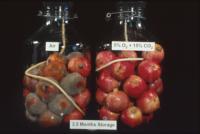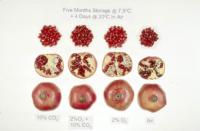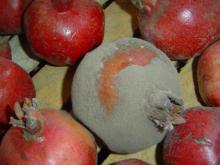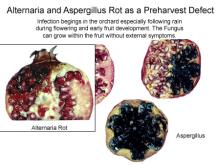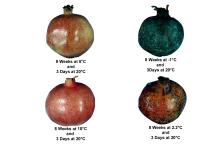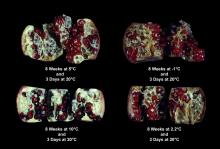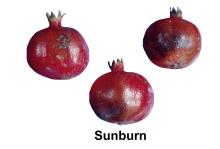Product Description
Índices de madurez
- Color externo rojo (de acuerdo al cultivar)
- Color de jugo rojo (igual a o más oscuro que 5R-5/12 de la guía de colores Munsell)
- Acidez de jugo inferior a 1.85%
- Ausencia de grietas de crecimiento, cortes, magulladuras y pudrición
- Color y lisura de piel
- El sabor depende del cociente azúcar/acidez, que varía entre los cultivares. Es deseable un contenido de sólidos solubles mayor al 17%
- Es deseable un contenido de taninos inferior a 0.25%
Manejo y almacenamiento poscosecha
A 5°C (41°F) por un máximo de 2 meses; para un almacenamiento más prolongado, se debe usar una temperatura de 10°C (50°F) para evitar daños por frío.
90-95%
Las granadas son muy susceptibles a la pérdida de agua que produce arrugamiento de la piel. El almacenamiendo de la fruta en un revestimiento o forro de plástico o el uso de ceras pueden disminuir pérdidas de agua, especialmente en condiciones de humedad relativa baja.
| Temperatura | 5°C (41°F) | 10°C (50°F) | 20°C (68°F) |
| ml CO2/kg·hr | 2-4 | 4-8 | 8-18 |
Para calcular el calor producido, multiplique mL CO2/kg·h por 440 para obtener BTU/ton/día o por 122 para obtener kcal/ton métrica/día.
Menos de 0.1 µL/kg·h a 10°C (50°F) y menos de 0.2 µl/kg·h a 20°C (68°F).
La exposición a una concentración igual o mayor a 1 ppm de etileno, estimula la respiración y la tasa de producción del etileno, pero no afecta las características cualitativas de la fruta. Las granadas no maduran tras la cosecha, por lo que deben cosecharse completamente maduras para asegurar la mejor calidad para el consumo.
Se han efectuado muy pocos estudios sobre el efecto de la AC en las granadas. Si se almacenan a menos de 5°C (41°F), las concentraciones del 2% O2 ayudan a disminuir los daños por frío. En un estudio, se pudo almacenar granadas exitosamente a 6°C (43°F) en un atmósfera de 3% O2 + 6% CO2 por 6 meses.
Physiological and Physical Disorders
Daño por Frío. Entre los síntomas externos, se encuentra la coloración parda de la piel y una mayor susceptibilidad a la pudrición. Entre los síntomas internos, se encuentra un color pálido de los arilos (la pulpa que rodea la semilla) y una coloración parda de los sectores blancos que separan los arilos. Se produce daño por frío cuando las granadas se mantienen a temperaturas entre el punto de congelamiento -3°C (26.6°F) y 5°C (41°F) por más de un mes, o a 5°C (41°F) por más de dos meses.
Desórdenes
Pudrición Interna (Heart Rot). Puede ser causada por Aspergillus spp. y Alternaria spp. En la fruta afectada, se observa un color de piel levemente anormal, y una masa interna de arilos ennegrecidos. Se desarrolla la enfermedad cuando la fruta se encuentra en el árbol. En la empacadora, se pueden identificar y remover los frutos afectados mediante seleccionadores.
References
En el futuro se añadirán referencias procedentes de fuentes científicamente validadas.





